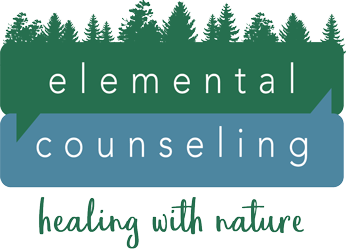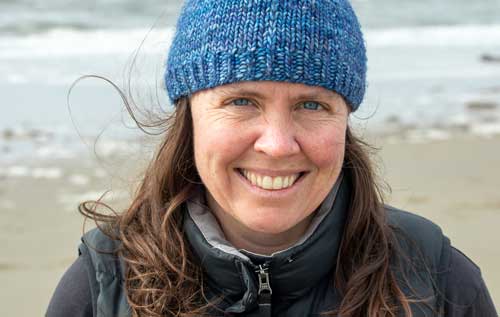This is the third in a series of posts about how to be an ecotherapist. If this interests you, also check out ‘So You Want to be an Ecotherapist’ and ‘Values of Ecotherapy’. Specifically in this post, I’m talking about taking clinical work outdoors. (Ecotherapy is very possible indoors, but that is not my focus here. Stay tuned for a later post on that one!) Taking clinical work outdoors means making a profound shift in the clinical container. Overall, I see a shift towards an outdoors container as tremendously positive. It provides so many expanded opportunities for interaction, connection, and exploration. However, it does require a significant level of flexibility, creativity, attention, and trust in the human/more than human relationship. There are many, many more variables outside of your control in the outdoor container compared to a traditional office. Explore what that brings up for you before you go out with a client.
I love outdoor work and personally my practice is probably 80% outdoors (Anecdotally, I’d say this is on the higher end for most ecotherapists doing 1:1 work–I share it simply to say it’s possible, not at all to say that it is the ‘right’ way. It’s what works for me, for now. Explore with what works for you.) Despite my passion for outdoor work, I do believe there are times an outdoor container may not be appropriate because of weather, client needs, and other variables. We need to have options for indoor work/telehealth in our own practice, or a screening/referral process that filters clients who may need an indoor container to clinician who can offer that.
Find systems and routines to support you
There are a lot of logistics involved with outdoor work. (Locations, directions, parking, weather contingencies, accessibility, confidentiality considerations, etc.) To me, these are all worth navigating because it means I get to work the way I am most effective and content. But the logistics do take time that is not typical of traditional clinical work, particularly in the early stages of figuring out how/where you want to practice ecotherapy. It will benefit you to develop clear systems and routines that help streamline all of these considerations.
Know your locations
If you are working with folks outdoors, know your parks/trails/wherever intimately. If the worst case scenario happens and you or a client is injured/ill out on a trail, you need to be able to describe exactly where you are and the shortest way from you to the road. You will also be more effective in your clinical work if you are fully comfortable in and connected to the land on which you are working.
Safety and Risk Training
Get the appropriate health and safety training for the work you are doing. I work with clients primarily on trails not far from town. We are rarely more than a mile from the road and always have cell phone reception. For me, Wilderness First Aid feels like a sufficient level of first aid training because no matter where I am with a client, I know I’m in a place I can call 9-1-1 and access medical professionals very quickly. If you are considering working in locations farther from help or out of cell phone range, I would strongly recommend you obtain a Wilderness First Responder or similar advanced first aid certification specific to wilderness scenarios. (And of course, you should also have the hard skills necessary to safely navigate and support others in whatever type of landscape you are in and know how to access emergency services for that area.)
What to bring
Be prepared! Even being close to town, I always carry a backpack with a first aid kit, water, sunscreen, bug spray, mats to sit on, extra layers of clothing appropriate for the season, etc. (I know what to pack for preparedness here in northern New England–no doubt there are different considerations based on location.) Know your place and what it takes to be as safe there as possible. Also have binoculars, a magnifying glass, a sketchbook, etc., as you never know what you might see that calls for closer attention. Assume you will need to share with your clients.
Accessibility
It is important to have a sense of our client’s mobility–although barriers can sometimes be obvious, more often I find mobility restrictions can be subtle. I ask explicitly if clients have any mobility or balance concerns and if their doctor would approve of them walking on uneven ground, trails with roots, etc. I suggest session locations based on these responses and my knowledge of the terrain. I also intentionally scouted an outdoor location in my town that has paved, wide trails and shelter accessible to wheelchairs.
I am keenly aware that at this time, I have tremendous privilege in my relatively healthy body and unrestricted mobility and that will not last forever. Although I have not spent a ton of time yet thinking about how I will practice when my body is no longer as mobile, I do think there are ways to engage with outdoor work with varied levels of personal health and mobility on the clinician end.
Confidentiality outdoors
This is many clinician’s first question, which makes sense as confidentiality is such an important principle of counseling. I am lucky to have several trail options nearby, many of which are often empty or close to it. I have a conversation about this and obtain written consent with each client before we go outdoors. This covers:
-
- I cannot guarantee confidentiality in a public space.
- I am on trails for personal and professional reasons constantly. If I see someone I know, my first response will be to avoid them, which is possible most of the time. If it is not, I will say something like, “Hi, it’s good to see you, let’s catch up later” and keep moving in a way that clearly indicates I cannot stop to talk.
- What the client wants to do if we run into someone they know.
In hundreds of outdoor sessions, I have had less than a handful of times where I or a client have run into someone we know, and it has always been easily handled in a way that did not derail (and sometimes benefited) the session. It is important to note that there is a small part of my brain that is very much tuned into what is happening all around us during a session. This allows me to proactively ask minimize contact with other humans by guiding us off trail or in a different direction when needed. For me, preparing ahead of time, gaining consent, and being able to process any interactions with other humans in the moment more than mitigates the risk of confidentiality breaches.
What about weather?
Yep, that’s definitely important, at least here in my region. First, honestly assess your comfort and ability in different types of weather. If you aren’t feeling comfortable, you will not be able to be fully present for your clients. For me, high winds, freezing rain, unsafe driving conditions, and temps below zero are my hard line situations for bringing a session indoors or rescheduling. I can work with most other scenarios. (At least at this point in my life with a body that is relatively healthy and mobile. No doubt, that will change significantly as time goes by, and I will adjust my approach as needed.) That’s me; look at what works and doesn’t work for you. If you can’t imagine being outside more than an hour when it’s below freezing or whatever else–don’t! Set the parameters that make sense for your climate/your practice/your body and communicate those clearly to clients.
Also, have an honest conversation with clients about types of weather they are comfortable/prepared to be out in. (If they say they are ready to be out in the snow but only own sneakers, this is a good time to have a conversation about boundaries, self-care, or whatever framework is connected to your client’s goals!) Have a back up plan for times when weather or conditions are not conducive to meeting outdoors, and make sure your clients know what to expect and who makes that call and when.
Because I know I’m more content to be outdoors in most weather situations than most of my clients, I generally let them make the call. I appreciate that it is a chance for them to pause, reflect, notice what works and doesn’t for their bodies and minds, and think about whether to reschedule/meet indoors at the planned time. This works for me and how my scheduling is set up, but I know it would not work for a lot of people. That’s totally fine, the only right way to do this is the way that works for you and your clients! Just make sure you’ve thought it through and communicate your policy clearly.
I actually appreciate all these additional ‘complications’ because each is an opportunity to support my clients in more deeply reflecting on themselves as animals in the world and to notice how they are impacted by the world around them. As they say, it’s all ‘grist for the mill’.
Whoa, that’s a lot.
It did feel that way in the beginning, but once I got my systems in place, I hardly even have to think about it. You will find the way that works for you/your business. And it really is so worth it. I get to spend most of my day outside and moving in beautiful places, my clients and I have the constant support of nature as a ‘co-therapist’, and nature (I hope) gets some short and long term benefit from our caring and attentive presence.


